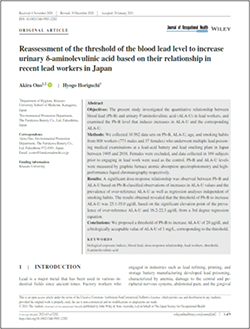#0116 Reassessment of the threshold of the blood lead level to increase urinary δ-aminolevulinic acid based on their relationship in recent lead workers in Japan

Japanese Scientists Clarify the Relationship Between Blood Lead Levels and a Urinary Biomarker of Lead Exposure
Lead is a key industrial metal produced in great quantities, but lead exposure can lead to serious medical problems in people employed in lead-related industries. Lead exposure can have many biological effects on human beings, and one of them is an increase in urinary levels of a compound called δ-aminolevulinic acid, hereafter referred to simply as “ALA.” Many occupational health experts regard urinary ALA levels as highly sensitive indicators of the health effects of lead exposure, and occupational health researchers have invested considerable efforts into understanding the relationship between blood lead levels and urinary ALA levels. Researchers are particularly interested in knowing the minimum blood lead level that will result in elevated urinary ALA levels because such information will help regulators determine the maximum safe levels of lead exposure for people working in lead-related industries.
To provide a better understanding of these issues, we decided to launch an investigation, the results of which appear in a recent article in the Journal of Occupational Health. For our research, we analyzed data from 704 men who worked at a lead-acid battery and lead-smelting plant in Japan and who consequently underwent medical assessments for lead poisoning at multiple timepoints, with the result that we had access to 10,067 datasets of blood lead levels and urinary ALA levels. As a control dataset, we used data from 169 individuals who underwent the relevant assessments prior to starting work with lead.
As expected, the analyses confirmed a relationship between higher blood lead levels and higher urinary ALA levels. The minimum blood lead level expected to result in higher-than-normal urinary ALA levels was 25.1–30.0 μg/dL. Our analyses also suggested that occupational health workers should regard a urinary ALA level of 1 mg/L as the maximum acceptable level.
In conclusion, this investigation’s results provide valuable clarification on the relationship between blood lead levels and urinary ALA levels. The results should aid efforts to adequately regulate lead exposure levels for people who work with lead.

Link to the original journal article:
https://onlinelibrary.wiley.com/doi/10.1002/1348-9585.12202
Title of the paper:
Reassessment of the threshold of the blood lead level to increase urinary δ-aminolevulinic acid based on their relationship in recent lead workers in Japan
Authors:
Akira Ono and Hyogo Horiguchi




